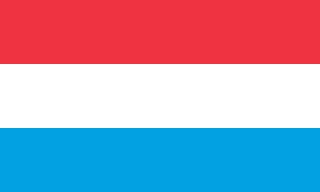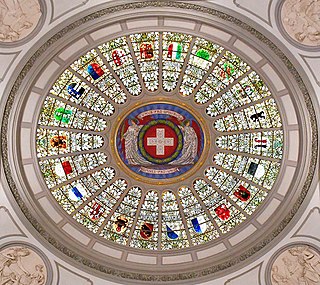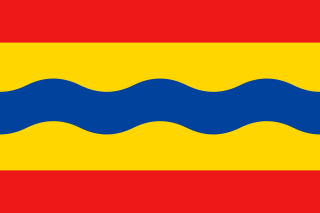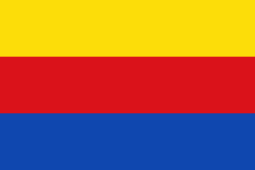
A national flag is a flag that represents and symbolizes a given nation. It is flown by the government of that nation, but can also be flown by its citizens. A national flag is typically designed with specific meanings for its colours and symbols, which may also be used separately from the flag as a symbol of the nation. The design of a national flag is sometimes altered after the occurrence of important historical events.

The national flag of Luxembourg consists of three horizontal stripes, red, white and light blue, and can be in 1:2 or 3:5 ratio. It was first used between 1845 and 1848 and officially adopted in 1993. It is informally called in the country, «rout, wäiß, blo».

The national flag of the Russian Federation is a tricolour of three equal horizontal bands: white on the top, blue in the middle, and red on the bottom.

The national flag of Antigua and Barbuda was adopted on 27 February 1967 to mark the achievement of self-government. A competition to design the flag was held in which more than 600 local people entered. The winning design was put forth by nationally well-known artist and sculptor Sir Reginald Samuel.

The flag of Portugal is the national flag of the Portuguese Republic. It is a rectangular bicolour with a field divided into green on the hoist, and red on the fly. The lesser version of the national coat of arms of Portugal is centered over the colour boundary at equal distance from the upper and lower edges. Its presentation was done on 1 December 1910, after the downfall of the constitutional monarchy on 5 October 1910. However, it was only on 30 June 1911, that the official decree approving this flag as the official flag was published. This new national flag for the First Portuguese Republic, was selected by a special commission whose members included Columbano Bordalo Pinheiro, João Chagas and Abel Botelho. The conjugation of the new field color, especially the use of green, was not traditional in the Portuguese national flag's composition and represented a radical republican-inspired change that broke the bond with the former monarchical flag. Since a failed republican insurrection on 31 January 1891, red and green had been established as the colours of the Portuguese Republican Party and its associated movements, whose political prominence kept growing until it reached a culmination period following the Republican revolution of 5 October 1910. In the ensuing decades, these colours were popularly propagandised, green represented the hope of the nation and the colour red represented the blood of those who died defending it, this happened to endow them with a more patriotic and dignified, therefore less political, sentiment.

The national flag of Ecuador, which consists of horizontal bands of yellow, blue and red, was first adopted by law in 1835 and later on 26 September 1860. The design of the current flag was finalized in 1900 with the addition of the coat of arms in the center of the flag. Before using the yellow, blue and red tricolor, Ecuador's former flag had three light blue stripes and two white stripes with three white stars for each province of the country. The design of the flag is very similar to those of Colombia and Venezuela, which are also former constituent territories of Gran Colombia. All three are based on a proposal by Venezuelan General Francisco de Miranda, which was adopted by Venezuela in 1811 and later Gran Colombia with some modifications. There is a variant of the flag that does not contain the coat of arms that is used by the merchant marine. This flag matches Colombia's in every aspect, but Colombia uses a different design when her merchant marine ships are at sail.

The national flag of Spain, as it is defined in the Constitution of 1978, consists of three horizontal stripes: red, yellow and red, the yellow stripe being twice the height of each red stripe. Traditionally, the middle stripe was defined by the more archaic term of gualda, and hence the popular name la Rojigualda (red-weld).

The national flag of Ukraine consists of equally sized horizontal bands of blue and yellow.

The current eight-star flag of Venezuela was introduced in 2006. The basic design includes a horizontal tricolour of yellow, blue, and red, dating to the original flag introduced in 1811, in the Venezuelan War of Independence.

Each of the 26 modern cantons of Switzerland has an official flag and a coat of arms. The history of development of these designs spans the 13th to the 20th centuries.

The flag of North Brabant consists of a chequy pattern with 24 distinct fields in the colours red and white or gules and argent. The flag has been used since the Middle Ages, but fell into disuse in the 18th century. The flag is now back in use, and has been the official flag of North Brabant since 1959.

The flag of Winnipeg was adopted in October 1975 to represent the City of Winnipeg. Today, the flag with its crest is used as the official representation of the city for ceremonial and official purposes, while the logo flag is used for promotional purposes.

The flag of Overijssel is the official flag of the province of Overijssel. The flag consists of two red and yellow stripes along with a blue wave in the middle. The current flag is the only one the province has ever had and has been a recognized provincial flag since 1948. The yellow and red stripes on the flag are supposed to represent the historical link with the province of Holland. The three colours are, namely, the colours of the coat of arms of Overijssel. In the centre of the flag, the wavy blue line represents the river IJssel, after which the province is named.

The flag of South Holland was adopted on 15 October 1985, replacing the flag used since 22 June 1948. The flag shows a red lion standing out prominently against an even yellow background. The flag of the most populous province is a banner of arms of the South Holland coat of arms. This shield is in turn grafted onto the coat of arms of Holland. The colour choice is also obvious; after all, yellow and red have traditionally been the colours of the province of Holland. Remarkably, the aspect ratio of the South Holland flag is 2:3, the same dimensions that also apply to the national tricolour. The left-facing lion, standing on its hind legs, occupies three-quarters of the flag's height and is equally distant from the top and bottom. The colours red and yellow are Holland's traditional colours and are also found of the flag of North Holland.

The flag of Sint Maarten consists of a white triangle situated at the hoist charged with the constituent country's coat of arms, along with two horizontal bands of red and blue. Adopted in 1985 shortly after the territory was granted a coat of arms, it has been the flag of Sint Maarten since 13 June of that year. Since the dissolution of the Netherlands Antilles on 10 October 2010, it has been the sole flag used in the constituent country.

The flag of Sabah, a state of Malaysia, was adopted on 16 September 1988. It is red, white and three different shades of blue. The mountain is in the canton as in the 1963 flag, but now in dark blue on a light blue background. The field is medium blue over white over red. The mountain shown on the flag is Mount Kinabalu.

The civil flag that serves as the symbol of the state of Mecklenburg-Vorpommern, Germany, consists of five horizontal stripes, that are from the top to bottom: blue (ultramarine), white, yellow, white, and red (vermilion). It was designed by Norbert Buske and adopted on 29 January 1991. It is a combination of the historical flags of the Mecklenburg and Western Pomerania.

The current flag of Weert was determined on 26 June 1980 as the municipal flag of the Limburgian municipality of Weert in the Netherlands. It replaced a previously determined flag from 1962. On 1 September 1980 the current flag was hoised for the first time during the official opening of the new municipal building at that time.

The flag that serves as the symbol of the historical and geographical region of the Western Pomerania is divided horizontally into two stripes: light blue on the top and white on the bottom. It originated as the flag of the Province of Pomerania, Prussia, used from 1882 to 1935. Since 1996, it is officially recognized as the symbol of the historical region of Western Pomerania within Mecklenburg–Western Pomerania, Germany.




















